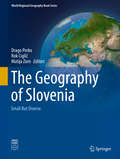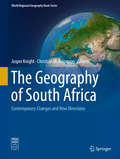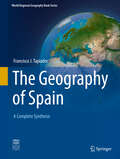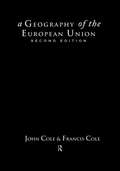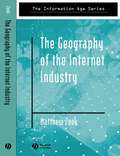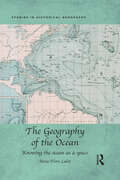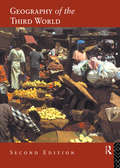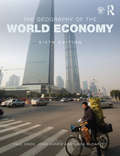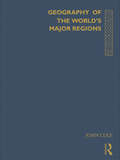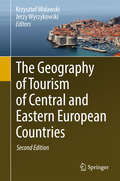- Table View
- List View
The Geography of Slovenia: Small But Diverse (World Regional Geography Book Series)
by Drago Perko Rok Ciglič Matija ZornThis book is the first to give a comprehensive and detailed overview of the complete geography of Slovenia in English. Only very few countries, even considerably larger ones, can boast the landscape diversity found in Slovenia since the Alps, the Pannonian Basin, the Dinaric Alps, and the Mediterranean meet and interweave in this small corner of Central Europe, as do Germanic, Hungarian, Slavic, and Romance cultural influences. The book provides a systematical overview of physical and human geographical elements of Slovenia from landforms to cultural characteristics. Special attention is given to landscape diversity, to the presentation of Slovene landscape types and regions, to some particularities and interesting facts of Slovenia, and to the position of Slovenia in the World. The book also illustrates some other important geographical phenomena, processes and interactions between nature and society in nowadays Slovenia. This volume appeals to researchers as well as students in the field of regional geography. It can also serve as a source for complete background information as well as a field guide for Slovenia.
The Geography of Small Firm Innovation (International Studies in Entrepreneurship #1)
by Grant BlackIt has long been recognized that advances in science contribute to economic growth. While it is one thing to argue that such a relationship exists, it is quite another to establish the extent to which knowledge spills over within and between sectors of the economy. Such a research agenda faces numerous challenges. Not only must one seek measures of inputs, but a measure of output is needed as well to estimate the knowledge production function. The identification of such a measure was a compelling goal for Zvi Griliches, if not the holy grail: “The dream of getting hold of an output indicator of inventive activity is one of the strong motivating forces for economic research in this area.” (Griliches 1990, p. 1669). Jaffe (1989) made a significant contribution to estimating the knowledge production function when he established a relationship between patent activity and R&D activity at the state level. Feldman and coauthors (1994a, 1994b) added considerably to this line of research, focusing on innovation counts as the dependent variable instead of patent counts. This work was particularly important given that many innovations are never patented. Feldman’s work also differentiated by firm size and showed that knowledge spillovers from universities play a key role as sources of knowledge for small firms.
Geography of Small Islands: Outposts of Globalisation
by Beate M.W. RatterThis book is dedicated to the study of the islands and their role in a globalised world. Beside Coastal or Oceanic/Marine Geography, there is little comprehensive material about the speciality of small island geography so far. This volume aims to bridge natural, social and cultural science perspectives. In Geography of Small Islands readers learn about the physical development of islands, their cultural and political importance, as well as their economic particularities. This book appeals to researchers, students and scholars with an interest in the special characteristics in spatialities of islands.
The Geography of South Africa: Contemporary Changes and New Directions (World Regional Geography Book Series)
by Christian M. Rogerson Jasper KnightThis edited collection examines contemporary directions in geographical research on South Africa. It encompasses a cross section of selected themes of critical importance not only to the discipline of Geography in South Africa, but also of relevance to other areas of the Global South. All chapters are original contributions, providing a state of the art research baseline on key themes in physical, human and environmental geography, and in understanding the changing geographical landscapes of modern South Africa. These contributions set the scene for an understanding of the relationships between modern South Africa and the wider contemporary world, including issues of sustainable development and growth in the Global South.
The Geography of Spain: A Complete Synthesis (World Regional Geography Book Series)
by Francisco J. TapiadorThis book is the latest and most comprehensive reference to the regional geography of Spain, taking into account emergent issues such as biodiversity, climate change and nationalism. It appeals to scientists as well as to students and instructors and all fields of geography, regional, environmental and cultural studies, and business related disciplines. It covers the whole range of topics from the physical to the human geography of Spain and provides detailed insights into all 17 autonomous communities. Dozens of GIS maps and hundreds of photographs and images including remote sensing imagery make this volume a must have for every geography department.
A Geography of the European Union
by John ColeCan the European Union continue to grow and also converge? Is uniformity within the union desirable? The European Union has grown into a supranational entity formed from a mosaic of diverse regions. Its enlargement to encompass a number of Central European countries seems only a matter of time. With the EU's political and economic importance growing globally, the Union's influence is increasingly being felt within its Member States. A new geography is emerging with pressures to reduce regional disparities by a process of convergence. A Geography of the European Union provides a comprehensive introduction to the European Union, its identity, problems and prospects. Focusing on the key issues of integration and enlargement, the authors examine the major economic, social, environmental and political aspects of the EU, both in terms of its individual regions and as a system of interdependent states that form the single EU entity. Assessment of controversial issues is frank: problems of unemployment, social stress, ageing and the place of women are covered objectively, prompting readers to form their own interpretations. This completely revised and expanded 2nd Edition includes a wealth of new illustrations, data and analysis. Setting the EU within a broader European and global context, this book provides a comprehensive introduction to the changing geography of the European Union and its place in a rapidly changing world.
A Geography of the European Union
by John ColeCan the European Union continue to grow and also converge? Is uniformity within the union desirable? The European Union has grown into a supranational entity formed from a mosaic of diverse regions. Its enlargement to encompass a number of Central European countries seems only a matter of time. With the EU's political and economic importance growing globally, the Union's influence is increasingly being felt within its Member States. A new geography is emerging with pressures to reduce regional disparities by a process of convergence. A Geography of the European Union provides a comprehensive introduction to the European Union, its identity, problems and prospects. Focusing on the key issues of integration and enlargement, the authors examine the major economic, social, environmental and political aspects of the EU, both in terms of its individual regions and as a system of interdependent states that form the single EU entity. Assessment of controversial issues is frank: problems of unemployment, social stress, ageing and the place of women are covered objectively, prompting readers to form their own interpretations. This completely revised and expanded 2nd Edition includes a wealth of new illustrations, data and analysis. Setting the EU within a broader European and global context, this book provides a comprehensive introduction to the changing geography of the European Union and its place in a rapidly changing world.
The Geography of the Internet Industry: Venture Capital, Dot-coms, and Local Knowledge (Information Age Series)
by Matthew ZookThis groundbreaking book analyses the geography of the commercial Internet industry. It presents the first accurate map of Internet domains in the world, by country, by region, by city, and for the United States, by neighborhood. Demonstrates the extraordinary spatial concentration of the Internetindustry. Explains the geographic features of the high tech venture capital behind the Internet economy. Demonstrates how venture capitalists' abilities to create and use tacit knowledge contributes to the clustering of the internet industry Draws on in-depth interviews and field work in San Francisco Bay Area and New York City.
The Geography of the Ocean: Knowing the ocean as a space (Studies in Historical Geography)
by Anne-Flore LaloëDespite the fact that the vast majority of the earth’s surface is made up of oceans, there has been surprisingly little work by geographers which critically examines the ocean-space and our knowledge and perceptions of it. This book employs a broad conceptual and methodological framework to analyse specific events that have contributed to the production of geographical knowledge about the ocean. These include, but are not limited to, Christopher Columbus’ first transatlantic journey, the mapping of nonexistent islands, the establishment of transoceanic trade routes, the discovery of largescale water movements, the HMS Challenger expedition, the search for the elusive Terra Australis Incognita, the formulation of the theory of continental drift and the mapping of the seabed. Using a combination of original, empirical (archival, material and cartographic), and theoretical sources, this book uniquely brings together fascinating narratives throughout history to produce a representation and mapping of geographical oceanic knowledge. It questions how we know what we know about the oceans and how this knowledge is represented and mapped. The book then uses this representation and mapping as a way to coherently trace the evolution of oceanic spatial awareness. In recent years, particularly in historical geography, discovering and knowing the ocean-space has been a completely separate enterprise from discovering and colonising the lands beyond it. There has been such focus on studying colonised lands, yet the oceans between them have been neglected. This book gives the geographical ocean a voice to be acknowledged as a space where history, geography and indeed historical geography took place.
The Geography of the Ocean: Knowing the ocean as a space (Studies in Historical Geography)
by Anne-Flore LaloëDespite the fact that the vast majority of the earth’s surface is made up of oceans, there has been surprisingly little work by geographers which critically examines the ocean-space and our knowledge and perceptions of it. This book employs a broad conceptual and methodological framework to analyse specific events that have contributed to the production of geographical knowledge about the ocean. These include, but are not limited to, Christopher Columbus’ first transatlantic journey, the mapping of nonexistent islands, the establishment of transoceanic trade routes, the discovery of largescale water movements, the HMS Challenger expedition, the search for the elusive Terra Australis Incognita, the formulation of the theory of continental drift and the mapping of the seabed. Using a combination of original, empirical (archival, material and cartographic), and theoretical sources, this book uniquely brings together fascinating narratives throughout history to produce a representation and mapping of geographical oceanic knowledge. It questions how we know what we know about the oceans and how this knowledge is represented and mapped. The book then uses this representation and mapping as a way to coherently trace the evolution of oceanic spatial awareness. In recent years, particularly in historical geography, discovering and knowing the ocean-space has been a completely separate enterprise from discovering and colonising the lands beyond it. There has been such focus on studying colonised lands, yet the oceans between them have been neglected. This book gives the geographical ocean a voice to be acknowledged as a space where history, geography and indeed historical geography took place.
A Geography of the Third World
by C. G Clarke Dr J Dickenson J. P Dickenson W.T.S Gould S Mather Sandra Mather Prof R Prothero R. M Prothero D. J Siddle C. T Smith Mr C Smith E. Thomas-HopeThe label of "Third World" covers half the land surface and three quarters of the population of the planet. The problems and potential of this region and its peoples are attracting increasing concern and interest.Fully revised and updated this edition includes: * a wealth of photographic and line illustrations* boxed case studies* chapter summaries* guides to further readingIssues of increasing concern at the end of the twentieth century are fully addressed - for example, the widening gap in economic performance between countries in the Third world and the assertion of national cultures in the face of globalisation. New material on gender issues and the environmental impact of development has been included.
A Geography of the Third World
by C. G Clarke Dr J Dickenson J. P Dickenson W.T.S Gould S Mather Sandra Mather Prof R Prothero R. M Prothero D. J Siddle C. T Smith Mr C Smith E. Thomas-HopeThe label of "Third World" covers half the land surface and three quarters of the population of the planet. The problems and potential of this region and its peoples are attracting increasing concern and interest.Fully revised and updated this edition includes: * a wealth of photographic and line illustrations* boxed case studies* chapter summaries* guides to further readingIssues of increasing concern at the end of the twentieth century are fully addressed - for example, the widening gap in economic performance between countries in the Third world and the assertion of national cultures in the face of globalisation. New material on gender issues and the environmental impact of development has been included.
The Geography of the World Economy: An Introduction To Economics Geography
by Paul Knox John A Agnew Linda MccarthyThe Geography of the World Economy provides an in-depth and stimulating introduction to the globalization of the world economy. The book offers a consideration of local, regional, national and global economic development over the long historical term. The theory and practice of economic and political geography provide a basis for understanding the interactions within and among the developed and developing countries of the world. Illustrated in color throughout, this new edition has been completely reworked and updated to take account of recent significant changes in the world economy. A new companion website also accompanies the book, with additional resources for each chapter including multiple choice and short essay questions and links to relevant websites. Figures and tables are also available for download located at www.routledge.com/cw/knox The text is signposted throughout with an glossary of key terms, and is richly illustrated with full-color maps, diagrams and illustrations. It is ideal for upper level university undergraduates and for post-graduates in a variety of specializations including geography, economics, political science, international relations and global studies.
The Geography of the World Economy
by Paul Knox John A Agnew Linda MccarthyThe Geography of the World Economy provides an in-depth and stimulating introduction to the globalization of the world economy. The book offers a consideration of local, regional, national and global economic development over the long historical term. The theory and practice of economic and political geography provide a basis for understanding the interactions within and among the developed and developing countries of the world. Illustrated in color throughout, this new edition has been completely reworked and updated to take account of recent significant changes in the world economy. A new companion website also accompanies the book, with additional resources for each chapter including multiple choice and short essay questions and links to relevant websites. Figures and tables are also available for download located at www.routledge.com/cw/knox The text is signposted throughout with an glossary of key terms, and is richly illustrated with full-color maps, diagrams and illustrations. It is ideal for upper level university undergraduates and for post-graduates in a variety of specializations including geography, economics, political science, international relations and global studies.
Geography of the World's Major Regions
by John ColeThis volume presents a global view of today's most pressing issues through an analysis of the twelve major regions of the world. Environmental degradation, natural catastrophe, population pressures and human conflict all impact in different ways and to different degrees on the society and environment of these regions. Economic and political restructuring within each region is covered, and topics include: natural resources; agriculture; industry and services; the role of the military; and the impact of global economic change. This work is intended as an introduction for students studying the changing geography of the world, but should also provide a useful overview to students researching specific regions, seeking comparative analysis of regions, or following general courses on the economic and political geography of both the post-industrial and the developing worlds. Over 250 photographs, maps and figures complement a range of boxed case-studies, key points, questions and guides to further reading.
Geography of the World's Major Regions
by John ColeThis volume presents a global view of today's most pressing issues through an analysis of the twelve major regions of the world. Environmental degradation, natural catastrophe, population pressures and human conflict all impact in different ways and to different degrees on the society and environment of these regions. Economic and political restructuring within each region is covered, and topics include: natural resources; agriculture; industry and services; the role of the military; and the impact of global economic change. This work is intended as an introduction for students studying the changing geography of the world, but should also provide a useful overview to students researching specific regions, seeking comparative analysis of regions, or following general courses on the economic and political geography of both the post-industrial and the developing worlds. Over 250 photographs, maps and figures complement a range of boxed case-studies, key points, questions and guides to further reading.
The Geography of Tourism of Central and Eastern European Countries
by Krzysztof Widawski Jerzy WyrzykowskiThis book presents a comprehensive overview of the tourism market development in Central and Eastern European countries. It is divided into 13 chapters, including a chapter dedicated to Belarus, all richly illustrated with colorful maps and illustrations. The book presents the output of international conferences organized every two years by the Department of Regional Geography and Tourism of the University of Wroclaw which have served as inspiration for this book. Chapter 1 provides the characteristics of 20 post-communist countries of the region on the international tourism market and it sets the background and context for the following chapters. Chapters 2 to 13 present the condition of research on tourism, tourist attractions, tourist infrastructure, tourism movement, main types of tourism as well as tourist regionalization in 12 Central and Eastern European countries. All chapters have been updated with reference to the statistics.This book is a revised and updated version of “The Geography of Tourism of Central and Eastern Europe Countries” published by the Department of Regional Geography and Tourism of Wroclaw University in 2012. It has been developed by a group of specialists through their exchange of research experience in the scope of international tourism in Central and Eastern Europe.
The Geography of Towns
by Arthur E. SmailesWhen first released much praise was given to this book: "An outstanding book on urban geography. . . representative of the best on this subject."--Higher Education Journal"The book ought to be required reading for every planner and student of planning . . . a magnificent achievement." --Town and Country Planning.The Geography of Towns provides a concise but thorough introduction to the important subject of urban geography. It traces the development of urban areas from the earliest sites of Nineveh, Aleppo, and Agade to modern megalopolises and strip cities, and deals authoritatively with problems of classification and ranking, location and type, origins, and course of development, and the relationship of the city to its region and nation.All facets of urban geography are covered, including the core, integuments, population structure, land-use patterns, enclaves, and town structure. Population mobility and the continual crisscross circulation of populations within and between town and region are seen as important forces affecting the internal geography of towns. The author questions the usefulness or validity of such terms as "neighborhood" and stresses the need for more meaningful conceptualizations and vocabulary.One of the fundamental problems connected with urban geography is to assist in the planning of future cities. This book contributes substantially to an understanding of the interrelations of town and region and to an understanding of the components of the city itself which are essential to intelligent planning for the future.
The Geography of Towns
by Arthur E. SmailesWhen first released much praise was given to this book: "An outstanding book on urban geography. . . representative of the best on this subject."--Higher Education Journal"The book ought to be required reading for every planner and student of planning . . . a magnificent achievement." --Town and Country Planning.The Geography of Towns provides a concise but thorough introduction to the important subject of urban geography. It traces the development of urban areas from the earliest sites of Nineveh, Aleppo, and Agade to modern megalopolises and strip cities, and deals authoritatively with problems of classification and ranking, location and type, origins, and course of development, and the relationship of the city to its region and nation.All facets of urban geography are covered, including the core, integuments, population structure, land-use patterns, enclaves, and town structure. Population mobility and the continual crisscross circulation of populations within and between town and region are seen as important forces affecting the internal geography of towns. The author questions the usefulness or validity of such terms as "neighborhood" and stresses the need for more meaningful conceptualizations and vocabulary.One of the fundamental problems connected with urban geography is to assist in the planning of future cities. This book contributes substantially to an understanding of the interrelations of town and region and to an understanding of the components of the city itself which are essential to intelligent planning for the future.
The Geography of Transport Systems
by Jean-Paul RodrigueThis expanded and revised sixth edition of The Geography of Transport Systems provides a comprehensive and accessible introduction to the field with a broad overview of its concepts, methods, and areas of application. It explores the spatial aspects of transportation and focuses on how the mobility of passengers and freight is linked with geography.The book is divided into ten chapters, each covering a specific conceptual dimension, including networks, modes, terminals, freight transportation, urban transportation, and environmental impacts, and updated with the latest information available. The sixth edition offers new and updated material on information technologies and mobility, e-commerce, transport and the economy, mobility and society, supply chains, security, pandemics, energy and the environment, and climate change. With over 140 updated figures and maps, The Geography of Transport Systems presents transportation systems at different scales ranging from global to local.This volume is an essential resource for undergraduates studying transportation, as well as those interested in economic and urban geography, transport planning and engineering. A companion website, which contains additional material such as photographs, maps, figures, and PowerPoint presentations, has been developed for the book and can be found here: https://transportgeography.org/
The Geography of Transport Systems
by Jean-Paul RodrigueThis expanded and revised sixth edition of The Geography of Transport Systems provides a comprehensive and accessible introduction to the field with a broad overview of its concepts, methods, and areas of application. It explores the spatial aspects of transportation and focuses on how the mobility of passengers and freight is linked with geography.The book is divided into ten chapters, each covering a specific conceptual dimension, including networks, modes, terminals, freight transportation, urban transportation, and environmental impacts, and updated with the latest information available. The sixth edition offers new and updated material on information technologies and mobility, e-commerce, transport and the economy, mobility and society, supply chains, security, pandemics, energy and the environment, and climate change. With over 140 updated figures and maps, The Geography of Transport Systems presents transportation systems at different scales ranging from global to local.This volume is an essential resource for undergraduates studying transportation, as well as those interested in economic and urban geography, transport planning and engineering. A companion website, which contains additional material such as photographs, maps, figures, and PowerPoint presentations, has been developed for the book and can be found here: https://transportgeography.org/
The Geography of Transport Systems
by Jean-Paul Rodrigue Claude Comtois Brian SlackThis expanded and revised fourth edition of The Geography of Transport Systems provides a comprehensive and accessible introduction to the field with a broad overview of its concepts, methods and areas of application. Aimed mainly at an undergraduate audience, it provides an overview of the spatial aspects of transportation and focuses on how the mobility of passengers and freight is linked with geography. The book is divided in ten chapters, each covering a specific conceptual dimension, including networks, modes, terminals, freight transportation, urban transportation and environmental impacts, and updated with the latest information available. The fourth edition offers new material on the issues of transport and the economy, city logistics, supply chains, security, energy, the environment, as well as a revised content structure. With over 160 updated photographs, figures and maps, The Geography of Transport Systems presents transportation systems at different scales ranging from global to local and focuses on different contexts such as North America, Europe and East Asia. This volume is an essential resource for undergraduates studying transport geography, as well as those interested in economic and urban geography, transport planning and engineering. A companion web site, which contains additional material, has been developed for the book and can be found here: http://people.hofstra.edu/geotrans/
The Geography of Transport Systems
by Jean-Paul Rodrigue Claude Comtois Brian SlackThis expanded and revised fourth edition of The Geography of Transport Systems provides a comprehensive and accessible introduction to the field with a broad overview of its concepts, methods and areas of application. Aimed mainly at an undergraduate audience, it provides an overview of the spatial aspects of transportation and focuses on how the mobility of passengers and freight is linked with geography. The book is divided in ten chapters, each covering a specific conceptual dimension, including networks, modes, terminals, freight transportation, urban transportation and environmental impacts, and updated with the latest information available. The fourth edition offers new material on the issues of transport and the economy, city logistics, supply chains, security, energy, the environment, as well as a revised content structure. With over 160 updated photographs, figures and maps, The Geography of Transport Systems presents transportation systems at different scales ranging from global to local and focuses on different contexts such as North America, Europe and East Asia. This volume is an essential resource for undergraduates studying transport geography, as well as those interested in economic and urban geography, transport planning and engineering. A companion web site, which contains additional material, has been developed for the book and can be found here: http://people.hofstra.edu/geotrans/
The Geography of Uncertainty: A Conceptual Model of Early Modern Globalization and the Current Crisis
by Alessandro RicciThis book outlines the characteristics and implications of a potential geography of uncertainty. In doing so, it analyses this concept in reference to both the origins of uncertainty in Early Modern Age and the current geopolitical situation. The book adopts an interdisciplinary approach to uncertainty, drawing on global perspectives and literature to define its meanings and characteristics. In order to develop a thorough and precise understanding of the geography of uncertainty, a broad perspective is adopted, which includes other forms of knowledge in which the concept of uncertainty is firmly established. As such the book creates temporal links, that may occasionally be far off from one another, to present a geographical perspective of uncertainty. It provides an interpretation of the phenomenon of globalization in a new way, relating it to the first European openness to global spaces, the Early Modern Age, and identifying the transition from the medieval world to the Modern Age as the first manifestation of uncertainty in geography. Uncertainty is more prevalent than ever in today's geopolitical, economic, financial and social reality, as well as the ongoing emergencies and crises. The book adopts an interdisciplinary approach rooted in the geography of Early Modernity by referring to geopolitical scenarios, literature and philosophy, to target the historical roots and the prevailing configuration of the geography of uncertainty. It will appeal to scholars and students of human and political geography, politics, philosophy, international relations, economics and history.
The Geography of Uncertainty: A Conceptual Model of Early Modern Globalization and the Current Crisis
by Alessandro RicciThis book outlines the characteristics and implications of a potential geography of uncertainty. In doing so, it analyses this concept in reference to both the origins of uncertainty in Early Modern Age and the current geopolitical situation. The book adopts an interdisciplinary approach to uncertainty, drawing on global perspectives and literature to define its meanings and characteristics. In order to develop a thorough and precise understanding of the geography of uncertainty, a broad perspective is adopted, which includes other forms of knowledge in which the concept of uncertainty is firmly established. As such the book creates temporal links, that may occasionally be far off from one another, to present a geographical perspective of uncertainty. It provides an interpretation of the phenomenon of globalization in a new way, relating it to the first European openness to global spaces, the Early Modern Age, and identifying the transition from the medieval world to the Modern Age as the first manifestation of uncertainty in geography. Uncertainty is more prevalent than ever in today's geopolitical, economic, financial and social reality, as well as the ongoing emergencies and crises. The book adopts an interdisciplinary approach rooted in the geography of Early Modernity by referring to geopolitical scenarios, literature and philosophy, to target the historical roots and the prevailing configuration of the geography of uncertainty. It will appeal to scholars and students of human and political geography, politics, philosophy, international relations, economics and history.
